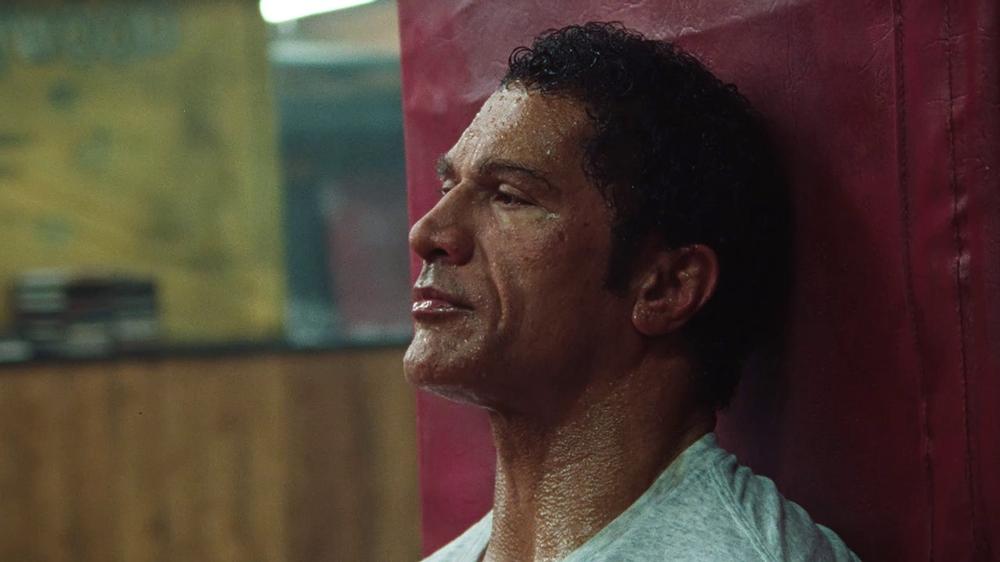The Smashing Machine is in theaters Friday, October 3rd.
There’s a scene somewhere in the middle of The Smashing Machine that involves a knife, a cactus and a mild disagreement. It’s a light argument plenty of the audience will be familiar with. It’s likely a lot of you have had this exact conversation, but the way this version of it is blocked, the way the props play into the subtext, it’s absolutely nerve-wracking. There’s a juxtaposition of violence and politeness at the center of this scene that makes The Smashing Machine a really fascinating movie to watch.
From Benny Safdie, half of the Safdie Brothers whose Good Time and Uncut Gems pulled exactly zero punches with their characters and subject matter, The Smashing Machine continues the filmmaker's trademark grounded and unflinching approach to obsessive people, just with a little less power behind its jabs.
The Smashing Machine is the true story of Mark Kerr and the early days of MMA fighting. It’s a biopic with an ending already written, and for writer/director Benny Safdie that’s kind of a first. Outside of Lenny Cooke, a documentary about a high school basketball phenom, Safdie’s stayed squarely in fiction, so a based-on-a-true-story sports movie from him is an interesting proposition. One of his defining attributes as a filmmaker is a kind of relentless realism that usually gets tied to stories of wildly obsessed people. While an MMA fighter seems a natural fit for Safdie’s storytelling, it’s the biopic part, where he’s handcuffed to some degree in terms of how much he can dramatize events that actually happened, that I was most curious about.
But before I get there, you have to start any conversation about this film with Dwayne Johnson. His turn as Kerr has of course been the subject of a lot of Oscar buzz and ovations at film festivals, and it is an impressive and altogether different performance from him. There’s a cynical way to look at the prosthetic make up and the kinda-impression of Mark Kerr he affects in his voice as Oscar-bait, but The Rock, as he’s wont to do, really did put in the work. This is truly a different kind of role for him and not just shades of the charismatic persona he honed in the ring for years.
But I don’t think the performance in a vacuum is Oscar caliber, but you have to appreciate how the film as a whole is built to highlight Johnson’s work. Benny Safdie put him in a precise position to succeed. He put him opposite Emily Blunt, who is unimpeachably great in everything. They clearly enjoy working together and they’re already buddies, so there’s a comfort level there that you can’t fake. Blunt, as Kerr’s girlfriend Dawn, has as interesting a journey as the titular Smashing Machine, with issues of her own to deal with. It’s the strength of Blunt’s performance that leaves an open question for most of the film: “who is the worse influence on whom?”
But when he’s not acting opposite Blunt, Johnson’s often working with non-actors. Ryan Bader, for example, does an absolutely fine job, admirable even, as Mark Coleman, Kerr’s best friend, training partner and sometimes opponent. Bader is an MMA fighter moonlighting as an actor, though as serviceable a performance as he gives, he doesn’t hold a candle to what The Rock is doing. Nor should he be expected to.
So the film sets up Johnson to look great whether he’s holding his own opposite Emily Blunt or looking better-by-comparison against a non-actor. As a result, his performance (Academy worthy or not) hits that much harder, and I’m willing to give Safdie as much credit for that as anybody. Of course at this point in his career, Johnson is savvy enough to stack a deck in his favor and, as a producer of the film, naturally he had a hand in that. The point here is, yes, Dwayne Johnson is as good as he’s ever been on screen, and it was very much a group effort.
But my favorite part of either of the Safdies’ work is their affinity for characters that just can’t put down the shovel. We meet them when they’re already in a hole and they’ll be damned if they can’t keep digging to get out of it. Adam Sandler in Uncut Gems and Robert Pattinson in Good Time, for example, have an inability to just stop and cut their losses, and don’t know how to quit while they’re ahead. And that’s why this is a very interesting turn from Benny Safdie, because here’s a guy in Mark Kerr who seemingly is ahead. He’s a guy who’s been so successful he literally can’t imagine losing. What makes The Smashing Machine a distinctly Safdie film is the fact that this inability to fathom what a loss feels like is played as though it’s just another kind of hole to dig out of.
Safdie builds these incredible montages built around Kerr pleasantly talking about the fear he instills in his opponents, and super casually describing that feeling while we watch him beat the ever-loving piss out of people. The music is just as polite, bucolic even, while Mark knocks his opponents senseless. There are moments throughout the movie when every technique in Safdie’s bag, from lenses to the edit to sound design, bring about a lightness of tone normally reserved for romcom montages of a couple's first date at the county fair. Only here they’re set against the struggle of a good-natured guy in an inherently violent sport trying to figure out what he is, if not The Smashing Machine.
That, I believe, is the most interesting, profile-worthy thing about Mark Kerr. He forged a path that helped turn MMA into an enormous industry and struggled along the way. He crawled so all the UFC guys you’ve heard of could run, so in that respect, Mark Kerr owns an interesting place in the sport’s history and it’s a story that ought to get told.
The thing The Smashing Machine is missing, however, is a sharp set of teeth. There aren’t too many edges that don’t seem to have been smoothed over, which keeps the film from really standing apart from other sports movies or properly living alongside other Safdie films. There are some truly great moments of filmmaking throughout, the aforementioned knife and cactus bit being one of my favorites. There are scenes where Safdie’s dedication to realism and the documentary-style camera work turn routine moments into legit pangs of emotions, like an elevator door opening at the wrong time bringing on a flood of sympathy. These things happen in a flash, but they nearly always land. It’s one of Safdie’s most incredible skills and it’s on display all over The Smashing Machine. These moments, on their own, I think are undeniably brilliant, worth studying even. The film, however, doesn’t quite reach the sum of its parts.
To return to the biopic aspect of The Smashing Machine, the film winds up feeling more honorary than anything else, as though the point of it may simply be that we all know Mark Kerr’s name. The teeth this film seems to be missing that were so present in Good Time and Uncut Gems (and oh man, Heaven Knows What before either of them) might only exist in Safdie fiction. The Smashing Machine seems to be a fairly unvarnished account of a few of the more intense years of Kerr’s life, certainly not all of it flattering, but the reality of making a biopic might have resulted in a pulled punch or two along the way.

 Sony’s updated PS5 Slim launches with less storage in Europe
Sony’s updated PS5 Slim launches with less storage in Europe